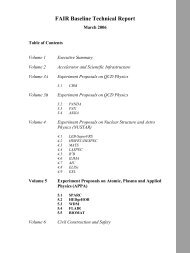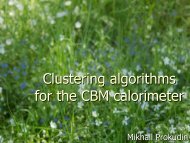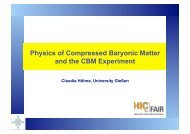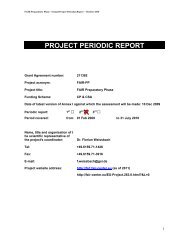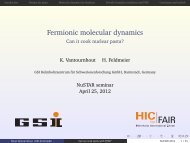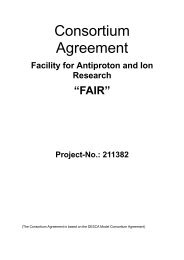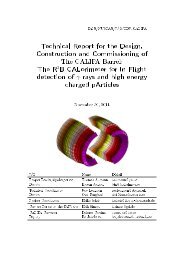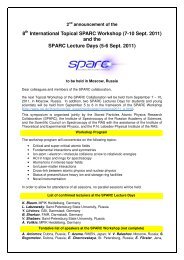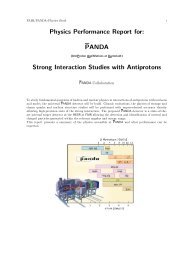NeuLAND - FAIR
NeuLAND - FAIR
NeuLAND - FAIR
Create successful ePaper yourself
Turn your PDF publications into a flip-book with our unique Google optimized e-Paper software.
8. Calibration<br />
8.1. Calibration with Fast Neutrons<br />
8.1.1. Calibration of a Subset of <strong>NeuLAND</strong> Modules<br />
The calibration of a fast-timing neutron detector for high-energy neutrons is a difficult<br />
task, since tagged neutron beams are rarely available. The experimental scheme, which<br />
we elaborated in order to measure time resolution, efficiencies and data patterns at high<br />
neutron energies, is detailed in the accepted GSI beam time proposal S406 [Bor-10].<br />
The most important points are summarized in the following. The demands are precise<br />
determinations of angle and energy of impinging neutrons on an event-by-event basis for<br />
high-energy neutrons.<br />
We will utilize neutrons stemming from a quasifree-scattering reaction of a deuteron<br />
beam on protons. The deuteron beam is delivered from SIS18 at GSI with energies<br />
between 200-1500 AMeV to the LAND reaction setup at Cave C, where the beam is<br />
impinging on a CH2 target. Quasifree-scattering reactions are selected by detection of<br />
both protons from the (p,2p) reaction in a wide angular range from 10 to 80 degrees. The<br />
two protons stemming from the quasi-free p knockout reaction exhibit typical angular<br />
correlations resulting in an opening angle ∆θ ∼ 90 ◦ and ∆Φ ∼ 180 ◦ . The angles are<br />
measured with Si-strip detectors. The energy of the protons is measured with the Crystal<br />
Ball detector. The transverse momentum of the spectator neutron is fixed by proton<br />
kinematics, thus we know where the neutron detector is hit. Figure 8.1 shows the<br />
angular distribution of protons for two incident beam energies. While for lower energies<br />
a symmetric distribution in the proton polar angles peaking around 43 ◦ is observed,<br />
an asymmetric distribution of angles is favored for beam energies above 500 AMeV,<br />
resulting, e.g., in two strong peaks at around 15 ◦ and 70 ◦ for a reaction at 1000 AMeV.<br />
Figure 8.2 shows exemplarily the spatial neutron distribution in 10 m distance from the<br />
target for the neutrons stemming from the quasifree scattering reaction at 250 AMeV<br />
deuterons on protons. In the following we detail how time resolution and efficiency of<br />
a subset of <strong>NeuLAND</strong> submodules will be determined in an experiment scheduled for<br />
the first half of 2012. Note, that the same beam time will be utilized as a calibration<br />
experiment for the existing LAND detector for characterization of event patterns.<br />
1. Time resolution:<br />
Since the detection of a neutron is mostly of destructive character, at least with<br />
respect to its momentum, studying the time resolution of neutron detectors is a<br />
81





